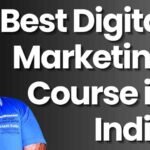Sunil Chaudhary’s Guide to Building a Successful Digital Marketing Strategy blends practical insights with timeless wisdom, offering a comprehensive approach for businesses and individuals looking to succeed in the ever-evolving digital landscape. In this guide, Sunil Chaudhary, a leading Digital Success Coach, outlines a strategic pathway that combines modern marketing techniques with thoughtful, purpose-driven action. The aim is not just to achieve success, but to build a sustainable and fulfilling digital presence that resonates with both your audience and your values.
1. Define Your Purpose and Vision
The foundation of a successful digital marketing strategy begins with a clear sense of purpose. According to Sunil Chaudhary, understanding why you are in business is crucial for shaping how you market your product or service. Your vision should be aligned with your core values, creating a roadmap that not only drives growth but also creates lasting impact.
- Ask Yourself: Why are you doing what you’re doing? What change do you want to bring in your industry or your customer’s life? How does your product or service align with that vision?
- Actionable Tip: Write a mission statement that encapsulates your vision and purpose. This will act as a guiding light in all your digital marketing efforts, ensuring that every campaign aligns with your larger goal.
2. Understand Your Audience: The Heart of Digital Marketing
Sunil Chaudhary emphasizes that knowing your audience deeply is at the heart of any successful strategy. Every digital marketing campaign should be customer-centric, solving their pain points and addressing their desires.
- Create Buyer Personas: Develop detailed profiles of your target audience based on demographics, psychographics, and behaviors. Understand their motivations, challenges, and where they spend their time online.
- Use Analytics: Dive deep into data from tools like Google Analytics, social media insights, and CRM systems to gather actionable information on user behavior, preferences, and interaction with your brand.
- Actionable Tip: Continuously engage with your audience through surveys, feedback, and social listening tools to stay attuned to their evolving needs.
3. Keyword Research: The Backbone of SEO
For any digital marketing strategy, Search Engine Optimization (SEO) plays a pivotal role in driving organic traffic. Sunil Chaudhary suggests that keyword research is the backbone of effective SEO. By understanding what terms your audience is searching for, you can tailor your content to meet those needs.
- Use Tools: Tools like Google Keyword Planner, SEMrush, and Ahrefs can help identify high-volume keywords, along with long-tail variations that may be less competitive but more targeted to your niche.
- Target Intent: Not all keywords are created equal. Focus on keywords that reflect the intent of your audience—whether they’re in the research phase, comparison phase, or ready to make a purchase.
- Actionable Tip: Organize your keywords by funnel stage and create specific content for each phase of the buyer’s journey. This ensures your audience is met with relevant content, no matter where they are in their decision-making process.
4. Content Marketing: Creating Value-Driven, Purposeful Content
Content is the fuel for a successful digital marketing engine. Sunil Chaudhary emphasizes the importance of creating high-quality, value-driven content that educates, engages, and empowers your audience.
- Diverse Content Types: Blog posts, videos, infographics, podcasts, and webinars are all powerful tools. Sunil Chaudhary recommends using a mix of these to cater to different audience preferences and platforms.
- Storytelling: Incorporating storytelling into your content creates a deeper connection with your audience. Share case studies, client success stories, or behind-the-scenes insights that humanize your brand.
- Actionable Tip: Create a content calendar that strategically plans out content based on your audience’s needs, seasonal trends, and key product launches. This ensures consistency and relevance.
5. Leverage Social Media for Engagement and Community Building
Social media is not just a promotional tool—it’s a platform for building a loyal community. Sunil Chaudhary stresses that engagement on social platforms like Facebook, Instagram, LinkedIn, and Twitter can help brands establish trust and loyalty.
- Be Authentic: Authenticity is key in social media marketing. Audiences today are savvy and can detect inauthenticity quickly. Share real stories, showcase behind-the-scenes moments, and interact with your followers genuinely.
- Utilize Paid Social Advertising: While organic growth is important, paid advertising on social platforms can give you the extra boost needed to reach new audiences. Use targeted ads to promote specific campaigns, products, or lead-generation initiatives.
- Actionable Tip: Regularly interact with your audience through polls, live Q&A sessions, and user-generated content campaigns to foster deeper relationships and encourage active participation.
6. Email Marketing: Personalized Communication for Nurturing Leads
Email marketing remains one of the most effective channels for nurturing relationships with potential customers. Sunil Chaudhary advocates for a personalized, segmented approach to email marketing that delivers the right message to the right audience at the right time.
- Segmentation: Divide your email list into segments based on demographics, buying behavior, and engagement level. Tailor your content for each segment, providing value and addressing specific needs.
- Automation: Set up automated email sequences for different stages of the buyer’s journey—welcome emails, follow-up sequences, cart abandonment emails, and post-purchase thank you messages. Automation ensures consistent communication without manual effort.
- Actionable Tip: Use A/B testing to optimize your subject lines, email content, and CTAs, ensuring that your emails are engaging and lead to higher open and conversion rates.
7. PPC and Online Advertising: Driving Targeted Traffic
While organic strategies are crucial, Sunil Chaudhary underscores the importance of Pay-Per-Click (PPC) advertising to drive immediate, targeted traffic. Platforms like Google Ads, Facebook Ads, and LinkedIn Ads offer extensive targeting capabilities, ensuring that your campaigns reach the right audience.
- Targeted Campaigns: Set up campaigns with highly specific targeting based on location, demographics, interests, and behaviors. Use retargeting ads to re-engage visitors who have interacted with your brand but haven’t converted.
- Monitor and Optimize: Continuously track your campaign performance using key metrics such as click-through rate (CTR), cost per click (CPC), and conversion rate. Make data-driven adjustments to improve your ROI.
- Actionable Tip: Use landing pages tailored to specific ads, with clear and compelling calls-to-action. This will increase conversion rates and reduce bounce rates.
8. Measure and Refine Your Strategy: Data-Driven Decision Making
In the digital marketing world, continuous improvement is the key to long-term success. Sunil Chaudhary highlights the importance of data-driven decision-making. Every strategy needs to be measured, analyzed, and refined based on performance metrics.
- Key Performance Indicators (KPIs): Track essential KPIs such as website traffic, bounce rate, conversion rate, cost per lead, and customer lifetime value (CLV). These metrics provide insights into the effectiveness of your campaigns.
- Use Analytics Tools: Leverage tools like Google Analytics, SEMrush, and social media analytics to gain a comprehensive understanding of your strategy’s performance.
- Actionable Tip: Regularly conduct performance audits and tweak your strategy based on data insights. Experiment with new tactics while phasing out underperforming elements.
9. Build Long-Term Relationships: Customer Retention and Loyalty
A successful digital marketing strategy doesn’t end with customer acquisition—it extends into building lasting relationships. Sunil Chaudhary emphasizes the importance of customer retention and loyalty programs.
- Follow-Up and Engage: Regularly communicate with your customers through follow-up emails, exclusive offers, and loyalty rewards. This fosters brand loyalty and encourages repeat business.
- Encourage Feedback: Customer feedback provides valuable insights and helps improve your products or services. Use reviews, testimonials, and surveys to continuously refine your offerings.
- Actionable Tip: Develop a referral program to incentivize your loyal customers to bring in new business, leveraging the power of word-of-mouth marketing.
Conclusion
Sunil Chaudhary’s guide to building a successful digital marketing strategy is a holistic approach that balances traditional marketing principles with cutting-edge digital tools. By focusing on purpose, audience understanding, and data-driven actions, you can create a sustainable and impactful digital presence that not only drives business growth but also creates value for your audience. Success in the digital world is not just about short-term wins, but about building a meaningful and lasting brand presence that resonates on a deeper level.
Understanding Digital Marketing
Digital marketing refers to the use of digital channels and technologies to promote products and services to consumers. Unlike traditional marketing, which relies on print advertisements, television, and face-to-face interactions, digital marketing encompasses a vast array of online platforms and tools. This includes social media, email campaigns, search engine optimization (SEO), and content marketing, among others. In the current business landscape, where digital interaction is paramount, companies must embrace these digital marketing strategies to remain competitive and connect with their audience effectively.
In today’s world, the significance of digital marketing cannot be overstated. With the ever-increasing reliance on the internet for information and shopping, businesses that neglect their online presence may find themselves overshadowed by competitors who leverage digital marketing effectively. Beyond enhancing visibility, digital marketing facilitates targeted outreach, allowing organizations to tailor their messaging based on demographics, interests, and behaviors. This tailored approach helps create more meaningful connections with consumers, resulting in higher engagement and conversion rates.
Several key channels define the digital marketing landscape. Social media platforms, such as Facebook, Instagram, and Twitter, serve as vital arenas for brand promotion and consumer interaction. Email marketing enables businesses to communicate directly with their customers, offering personalized messages and promotions. SEO is essential for improving visibility on search engines, while content marketing focuses on creating valuable content to attract and engage potential customers. When developing a digital marketing strategy, it is crucial to understand these channels and choose the ones that align best with specific business objectives.
When crafting a successful digital marketing strategy, businesses should adhere to fundamental principles, including understanding their target audience, setting measurable goals, and continuously analyzing performance metrics. Emphasizing adaptability and innovation is also critical, as digital trends and consumer behaviors can shift rapidly. By fostering a thorough understanding of digital marketing and its components, businesses can create effective strategies that drive growth and success in a complex digital landscape.
Setting Clear Objectives
Establishing clear objectives is a critical component of an effective digital marketing strategy. Objectives should adhere to the SMART criteria, which stands for Specific, Measurable, Achievable, Relevant, and Time-bound. This framework allows marketers to create focused goals that facilitate the planning and execution of their strategic initiatives. By setting SMART objectives, organizations can better align their marketing efforts with their overall business objectives, ensuring that every campaign is purposeful and quantifiable.
Specific objectives clearly outline what the organization aims to achieve. For instance, rather than simply stating that a company wants to increase sales, a specific goal could be to increase sales by 20% over the next quarter. Measurable objectives enable the tracking of progress, as quantifiable metrics aid in determining success. Achievable goals take into consideration the available resources and market conditions, ensuring that objectives are realistic and attainable.
Additionally, relevant objectives are essential; they must align with broader business goals. For example, if a company aims to enhance its brand awareness, the objective should directly support this ambition through targeted marketing efforts. Finally, setting time-bound objectives establishes a clear timeline for achievement, which can motivate teams and create a sense of urgency in executing campaigns.
Common objectives in digital marketing include increasing brand awareness, boosting sales, and enhancing customer engagement. By formulating these objectives within the SMART framework, marketers can implement strategies that not only enhance their efforts but also measure their impact over time. This approach fosters a data-driven mindset, allowing businesses to adapt their techniques based on performance and ultimately leading to a more successful digital marketing strategy.
Identifying Your Target Audience
Understanding your target audience is a fundamental step in crafting a successful digital marketing strategy. Identifying who your customers are allows marketers to tailor their content, messaging, and campaigns to resonate with specific groups effectively, significantly enhancing engagement and conversion rates. To accurately identify your target audience, one effective approach is to create buyer personas. These fictional representations of your ideal customers should incorporate demographic details, preferences, behaviors, and challenges. This enables marketers to visualize their audience and strategize accordingly.
Another critical method for audience research is the analysis of customer data. Utilizing analytics tools can provide valuable insights into audience behavior, including which pages they visit, how long they stay, and what content they engage with the most. By examining this data, marketers can identify patterns and trends that may indicate what their target audience values and how they prefer to receive information.
Segmentation is an essential aspect of understanding your audience. By dividing your audience into distinct segments based on shared characteristics, such as age, interests, or buying behavior, you can create more personalized marketing efforts that cater to the specific needs of each group. This level of customization can significantly improve the effectiveness of your campaigns, as personalized messaging tends to elicit a more favorable response from recipients.
Various tools and resources are available for effective audience analysis, including Google Analytics, social media insights, and customer relationship management (CRM) systems. Additionally, surveys and feedback forms can provide direct information from customers about their preferences and perceptions. By utilizing these resources, marketers can ensure that their strategies are aligned with the desires and expectations of their target audience, ultimately leading to more successful and impactful digital marketing efforts.
Choosing the Right Digital Marketing Channels
In the current digital landscape, selecting the appropriate marketing channels is a critical determinant of a business’s success. Various digital marketing channels, including social media platforms, email marketing, content marketing, search engine optimization (SEO), and pay-per-click (PPC) advertising, each serve unique purposes and reach distinct segments of an audience.
Understanding the target audience is paramount when choosing from these channels. For instance, younger demographics may engage more on platforms like TikTok or Instagram, while professionals often utilize LinkedIn for networking and information. Conducting thorough audience research through surveys, analytics, and segmentation can yield invaluable insights that inform channel selection. Aligning chosen channels with established business goals—such as increasing brand awareness or driving conversions—further enhances the effectiveness of the marketing strategy.
Diversifying marketing efforts across multiple channels is also advisable. By not relying on a singular channel, businesses can mitigate risks and maximize their reach. For example, while SEO may enhance organic search visibility, email marketing can nurture leads through personalized communication. Similarly, integrating PPC advertising can generate immediate traffic and raise brand awareness quickly. This approach not only broadens audience engagement but also allows for conducting A/B testing across channels to identify which tactics yield the best results.
Moreover, regular analytics monitoring is essential for evaluating the performance of each channel. Key performance indicators (KPIs) can guide adjustments and optimizations to the strategy. By continuously assessing the effectiveness of the chosen digital marketing channels, businesses can refine their approach, ensuring that they stay aligned with both audience preferences and evolving market trends. Ultimately, a well-considered selection of digital marketing channels leads to a more successful and sustainable growth strategy.
Creating Engaging Content
Content plays a pivotal role in the realm of digital marketing, acting as the foundation for successful engagement with target audiences. Various types of content can be employed to capture the interest of different demographic segments. Blog posts serve as a traditional yet effective medium for establishing authority and driving organic traffic to a website. Well-researched articles that address common pain points or offer solutions can cultivate audience trust and encourage regular visits.
In addition to written content, incorporating visual elements like videos and infographics is essential. Videos provide an engaging method to communicate complex ideas or narrate brand stories, appealing directly to users’ emotional and visual senses. Infographics, on the other hand, present data in a visually appealing format that facilitates quick understanding and retention, making them highly shareable across social media platforms.
Podcasts have also risen in popularity, offering an intimate medium for brand storytelling and industry discussions, enabling marketers to connect with their audience on a personal level. Each of these content types can effectively drive traffic, generate leads, and foster customer loyalty when tailored to audience preferences and interests.
To develop engaging and valuable content, it is crucial to understand the target audience’s needs and preferences. Conducting thorough research and analytics can provide insights into trending topics and content consumption behaviors. Implementing storytelling techniques can enhance the relatability of the content, allowing brands to establish a unique voice that resonates with followers. Brands should craft narratives that not only inform but also inspire and evoke emotions, ensuring a memorable customer experience.
Ultimately, a multi-faceted approach combining text, visuals, and audio can significantly elevate a digital marketing strategy, making the content more appealing and influential.
Implementing SEO Best Practices
Search Engine Optimization (SEO) is an essential component of any successful digital marketing strategy. By effectively implementing SEO best practices, businesses can enhance their visibility online, attract more organic traffic, and ultimately, drive conversions. A foundational step in this process involves thorough keyword research. Identifying relevant keywords that align with your target audience’s search intent allows marketers to optimize content effectively. Utilizing tools such as Google Keyword Planner or SEMrush can facilitate the discovery of high-volume keywords as well as long-tail variants that may have lower competition.
On-page SEO is equally vital, as it directly impacts how search engines interpret the relevance and quality of your content. This includes optimizing title tags, meta descriptions, header tags, and image alt texts. Engaging content that contains the primary keywords in natural flow is crucial for improving search engine rankings, while also enhancing user experience. Beyond this, the technical aspects of SEO must not be overlooked. Elements such as website speed, mobile-friendliness, and ensuring a secure connection (HTTPS) are critical in satisfying both users and search engine algorithms.
Link-building strategies also play a pivotal role in establishing authority. By acquiring quality backlinks from reputable websites, you enhance your site’s credibility and search engine rankings. This can be achieved through guest blogging, partnerships, or producing shareworthy content that compels others to link back to your resources. Additionally, staying updated with algorithm changes is essential; search engines continually refine their algorithms, and staying informed allows marketers to adapt their strategies accordingly.
In conclusion, mastering SEO best practices through strategic keyword research, meticulous on-page and technical optimization, and robust link-building strategies is imperative for any digital marketing initiative. By keeping abreast of ongoing developments in the SEO landscape, businesses can ensure that their digital marketing strategies remain effective and competitive.
Utilizing Data Analytics
In the ever-evolving landscape of digital marketing, utilizing data analytics has become essential for tracking and enhancing performance. Data analytics allows marketers to evaluate their strategies’ effectiveness, ensuring that resources are allocated efficiently to achieve the desired outcomes. One of the primary aspects of employing data analytics is the identification and monitoring of key performance indicators (KPIs). These metrics enable marketers to assess the success of campaigns, providing a concrete foundation for decision-making.
Common KPIs to monitor include website traffic, conversion rates, bounce rates, and customer acquisition costs. Each of these metrics contributes vital information regarding the effectiveness of digital marketing initiatives. For instance, high website traffic combined with low conversion rates may indicate a disconnect between audience interests and the content being provided. On the other hand, a high customer acquisition cost might prompt a reevaluation of the channels utilized for outreach. By focusing on these KPIs, marketers can gain valuable insights into their performance and implement necessary adjustments to optimize strategies.
Numerous tools are available to facilitate the analysis of data, ranging from Google Analytics to more specialized software such as Tableau or HubSpot. These platforms allow marketers to visualize their data, making it easier to identify trends and patterns. Additionally, integrating tools with Customer Relationship Management (CRM) systems can enhance overall insights by correlating marketing efforts with customer behavior. Leveraging these insights effectively can lead to continuous improvement in marketing strategies and, ultimately, better results.
By adopting a data-driven approach, marketers are empowered to make informed decisions that enhance their campaigns over time. The ability to analyze performance not only streamlines efforts but also fosters alignment between marketing approaches and business objectives. Ultimately, utilizing data analytics is pivotal in building a successful digital marketing strategy, positioning businesses for sustained growth in a competitive environment.
Testing and Optimization
In the realm of digital marketing, testing and optimization are critical components that contribute significantly to the overall success of a strategy. One effective method for evaluating and enhancing marketing performance is A/B testing, which involves comparing two or more variations of a particular element to determine which performs better. This can encompass a variety of aspects such as email campaigns, landing pages, and ad copy. By systematically analyzing user interactions with these elements, marketers can gather valuable insights to refine their approach and maximize conversion rates.
A/B testing should be an ongoing practice rather than a one-time effort. Continuous optimization involves regularly assessing data and making data-driven decisions to improve the effectiveness of digital marketing initiatives. When a particular campaign or element yields positive results, scaling these efforts is essential. For instance, if a specific email subject line leads to higher open rates, using it across a broader segment of the audience can amplify the overall effectiveness of communication. Conversely, it is equally important to recognize and pivot away from underperforming strategies quickly. Identifying low-performing content allows marketers to innovate, testing new approaches that align more closely with audience preferences and behaviors.
To ensure the success of testing and optimization efforts, several best practices should be observed. Maintain a clear hypothesis for each test and focus on one variable at a time to obtain accurate results. Additionally, setting a sufficient sample size before analyzing results is crucial; drawing conclusions from a limited dataset can lead to misguided decisions. Lastly, documenting all tests and outcomes enables marketers to establish a knowledge base for future campaigns, facilitating better planning and execution moving forward.
Staying Updated with Industry Trends
In the rapidly changing domain of digital marketing, it is crucial for professionals to remain informed about the latest trends, tools, and technologies. The digital landscape is constantly evolving, dictated by consumer behavior, technological advancements, and algorithm changes. To effectively navigate this space, marketers must embrace a proactive approach to learning and stay current with industry developments.
One of the most effective ways to stay informed is by attending webinars hosted by industry experts. These events often cover a range of topics, including new software, emerging strategies, and practical applications of the latest tools. Many organizations and digital marketing platforms provide free access to webinars, making this an accessible option for anyone looking to enhance their knowledge. Engaging with these sessions allows marketers to grasp intricate nuances and ask questions to clarify their understanding.
Another valuable resource is subscribing to reputable industry blogs and publications. Websites like Moz, HubSpot, and Marketing Land provide insightful articles, research, and case studies backed by data. Regularly reading these sources helps in recognizing prevailing trends and anticipating changes within the market. Digital marketing professionals may also consider following influential thought leaders on social media platforms, where a wealth of information is often shared in real-time.
Online courses can also serve as excellent tools for professional growth. Platforms such as Coursera and Udemy offer specialized courses that cater to diverse aspects of digital marketing, from SEO to content marketing. Additionally, networking opportunities, whether through events or online forums, allow for the exchange of ideas and trends among peers. By developing a mindset of continuous learning, digital marketers can ensure they remain competitive and effective in their strategies.








